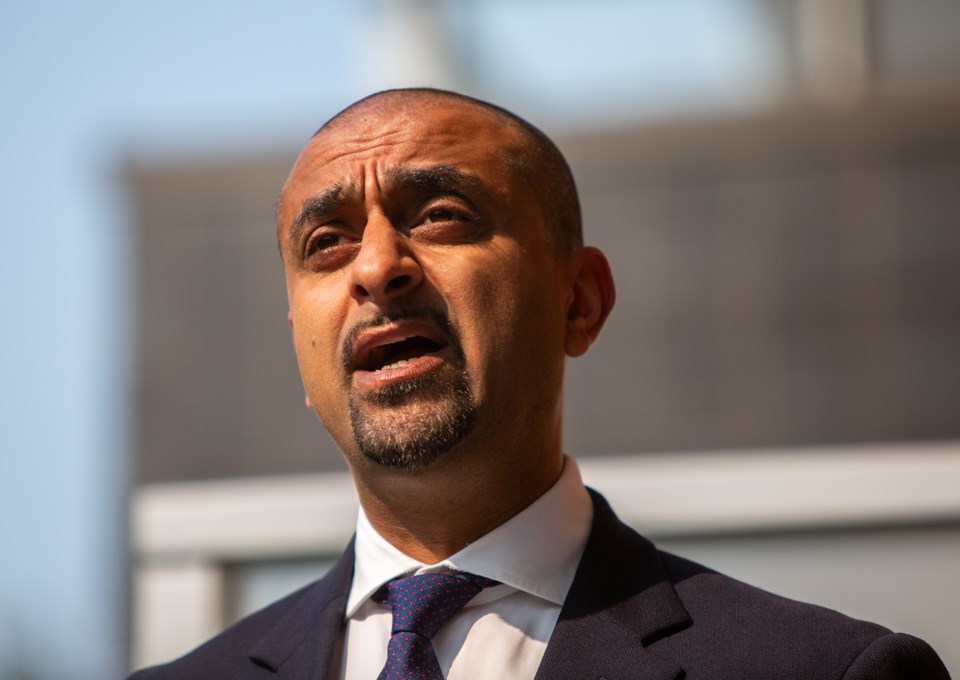A new pot of money announced Monday for affordable home construction in B.C. will not be directly funnelled to the 10 municipalities put on a “housing target” list earlier this year by Housing Minister Ravi Kahlon in what was a move to force the building of more homes.
The minister announced Monday that another round of applications via its $3.3-billion “community housing fund” is now open to municipalities, non-profits, First Nations and others to access money to build up to 3,500 units of housing.
The cost of the 3,500 units wasn’t disclosed, but it is estimated to be in the millions.
The funds will go to any municipality or organization that is successful in its application for affordable housing projects across B.C., despite the government putting 10 cities on a housing target list in May.
Asked why government would not set aside funds solely for the 10 cities and other organizations to incentivize and accelerate construction, Kahlon said: “Well, because it's not only those communities that need the housing, but they're the ones who need more housing.”
Government has dedicated $3.3 billion via its community housing fund to build more than 20,000 affordable rental homes by 2031-32 for people with moderate and low incomes.
The 3,500 units announced Monday are part of that calculation.
1,475 units
So far, the government says approximately 9,000 homes via the fund are open or underway throughout B.C. — a statistic BC United’s housing critic, Karin Kirkpatrick, questioned, pointing to an exchange she had with Kahlon in the legislature in April.
A Hansard transcript of that exchange quotes Kahlon as saying 1,475 units were completed under the community housing fund. The minister then goes on to say more than 32,000 homes were either complete or in development under the NDP’s various housing programs.
Kirkpatrick said the government originally promised 14,000 homes under the community housing fund. Now that promise has increased to 20,000, she said, noting promises don’t equate to completed housing.
“Those numbers aren't real,” Kirkpatrick said Tuesday. “We don't care what's being contemplated. We care when the doors open and somebody can actually move into something.”
Added Kirkpatrick: “It’s taking them five years to complete 1,475 units, so I've lost confidence in their ability to manage this community housing fund.”
Staff at the housing ministry provided data Tuesday to Glacier Media that said 2,200 homes under the housing fund are open, 3,639 are under construction, 1,617 are in development and 1,491 are "initiated," as of June 2023.
In May, Kahlon placed Vancouver, Victoria, Kamloops and seven other cities on a list to push them to build more homes — and build them faster. The other cities are Abbotsford, Delta, Port Moody, West Vancouver, Saanich, Oak Bay and the District of North Vancouver.
Kahlon said the cities were selected with the assistance of housing experts and economists, who factored in housing availability, affordability and “unrealized potential in delivering more homes for people.”
'In the province's court'
But Kirkpatrick, who is the MLA for West Vancouver-Capilano, pointed to a project approved by the District of North Vancouver council in 2021 that has yet to break ground. She criticized BC Housing, the provincial government’s housing arm, for the delay.
“It has been sitting on the desk of somebody at BC Housing since then,” Kirkpatrick said. “So when the district is being told, ‘Hey guys, you need to get more housing built,’ it's actually in the province’s court to actually move it forward.”
Kirkpatrick, however, doesn’t think there should be a dedicated budget for the 10 cities on the list, saying it wouldn’t be fair to other municipalities that have built their fair share of housing.
“I could see where maybe other municipalities would say, ‘Hey, wait a minute, you're actually rewarding municipalities who haven't been keeping up with growth and doing what they should have been doing in terms of housing,’” she said.
In November 2022, the government introduced the Housing Supply Act to give it the authority to set housing targets in municipalities, starting with those with the greatest need and highest projected growth.
The targets are supposed to encourage municipalities to address local barriers to construction so that housing can get built faster, including updating zoning bylaws and streamlining local development approval processes.
The government has yet to release how many units each of the 10 cities on the list should build — data that was expected this summer. More cities are supposed to be added to the list before the end of the year.
'A balancing act'
Thom Armstrong, CEO of Co-operative Housing Federation of B.C., echoed Kirkpatrick’s concerns about dedicating money to the 10 cities, some of which he said will be applying for money anyways under the community housing fund.
At the same time, Armstrong added, he’s in favour of a more aggressive approach but not one that creates a disadvantage for a city already building as much housing as it can.
“It's a balancing act,” he said. “But, yes, it should be used to incentivize municipalities to do more, but not at the expense of places that are already ready to rock and roll.”
Kahlon said criteria used to select the cities or organizations eligible for money via the community housing fund will incorporate a scoring system that considers the 10 municipalities targeted on the list.
“Certainly, when you have the formula that's going to look at proposals, there is going to be a slightly higher score for those communities that are in the target communities,” he said.
“That has been reflected in our scoring of applications. But the need is everywhere, and it's not just in a few communities.”




